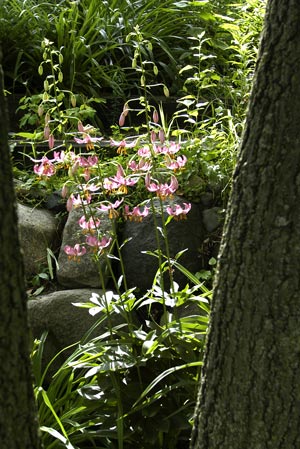First, what is a lily?
 Sometimes gardeners will tell us enthusiastically that they grow lilies . . . “Lemon Lilies” and “Tawny Lilies” (Hemerocallis) and “Calla Lilies” (Zantedeschia). Or they will appear at a lily show with a handsome exhibit of “Magic Lily” (Lycoris) or “Torch Lily” (Kniphofia). These are beautiful flowers, and it is not surprising that they are considered to be lilies. But true lilies . . . or to be technical… members of the genus Lilium have special characteristics that differentiate them from other “Lily” plants. The bulb is usually the most distinguishing characteristic. It is composed of fleshy scales without a protective outer coating. A true lily is never dormant . . . it must be considered and treated as a living perennial plant. Lily bulbs may be kept in cool storage for a few months, but special care must be taken to keep them fresh and moist.
Sometimes gardeners will tell us enthusiastically that they grow lilies . . . “Lemon Lilies” and “Tawny Lilies” (Hemerocallis) and “Calla Lilies” (Zantedeschia). Or they will appear at a lily show with a handsome exhibit of “Magic Lily” (Lycoris) or “Torch Lily” (Kniphofia). These are beautiful flowers, and it is not surprising that they are considered to be lilies. But true lilies . . . or to be technical… members of the genus Lilium have special characteristics that differentiate them from other “Lily” plants. The bulb is usually the most distinguishing characteristic. It is composed of fleshy scales without a protective outer coating. A true lily is never dormant . . . it must be considered and treated as a living perennial plant. Lily bulbs may be kept in cool storage for a few months, but special care must be taken to keep them fresh and moist.
Lily flowers, though completely varied in size, shape and color, always have six tepals and six anthers. Stems, leaves and roots have distinguishing features too.
Why grow lilies?
 There are many reasons we could give for growing these delightful flowers …. but mere words are such an inadequate medium for describing such a plant!
There are many reasons we could give for growing these delightful flowers …. but mere words are such an inadequate medium for describing such a plant!
If we could just take you by the hand and lead you amongst the entrancing displays at a lily show . . . then you could see for yourself how lovely and varied and colorful they are. Was there ever anything so white and pure and regal as the Trumpets . . . or the deep gold and chartreuse and melon of the flouncy-petaled Aurelians! Notice the bright sparkling colors of the freckled-faced Asiatics . . . and the sequin-studded satiny crimson of the Auratum Hybrids. Smell the heavenly fragrance ……… ummmmmmm……. wouldn’t you love to have a garden full of lilies!
They bloom over a long period too . . . . even all winter under glass! With the long blooming season and the diversity of shapes, sizes, colors, and types you will never discover all their secrets. They will never bore you.
Lilies are prolific too. Easily (but not too easily!) grown from seed, and the flower parts are large enough so that hybridizing can be attempted without magnifying glasses. Wouldn’t it be fun to become a lily “expert”!
Where to use lilies
Well, maybe you don’t feel like specializing right now . . . perhaps you just want to grow a few lilies to add interest to the rest of your garden. Maybe you need some important flowers to bloom in late June or Early July when there is a lack of color in the border . . . after the Iris and Peonies finish and before the annuals take over.
Lilies mix very well with most garden flowers . . . perennials as well as annuals. The slender stems do not take up much room, and the gorgeously fragrant blooms are displayed up above the lower companion plants. Unless a plant is particularly greedy or invasive, it may happily share the same garden as your lilies. Lilies are suitable for use in a shrub border, as accent plants, a formal or naturalized pool planting. Even some of the small species would fit perfectly in an alpine rock